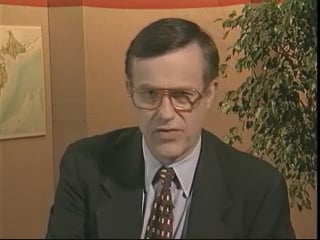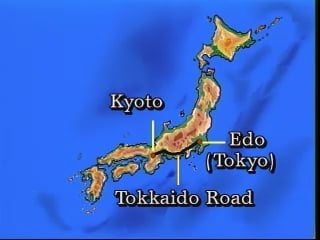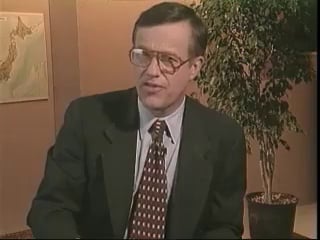Playlist: Introduction to Tokugawa Japan
Order and Change: Political Stability and Rapid Modernization
Transcript
Robert Oxnam: Tokugawa Japan spanned the years 1600 to 1868. Thus the Tokugawa era began at the same time European colonists came to what would later be the United States, and ended just after the American Civil War.
For Japan, the Tokugawa era brought 250 years of peace and order, a long-term stability that fostered great changes in Japanese society, readying it for entering the modern era. Japan's rapid modernization in the late nineteenth century — the so-called Meiji era — is well known. Less well known are the crucial preparatory steps that were taken in the Tokugawa period.
Carol Gluck: The Tokugawa period, which in Japan begins in 1600 and ends in 1868, is important for what happens before it and what happens after it. Before the Tokugawa period, Japan was a country of warring states, it was not unified, it was medieval, as we call it, medieval Japan.
So that the first importance of Tokugawa has to do with the creation of a centralized state, a national system.
And the second importance of it has to do with what followed the Tokugawa, and that is the modern period, which began in 1868, and so we need to think about what happened during the Tokugawa period that relates to modern Japan. So, it is between the medieval and the modern, it is early modern Japan. And we think of it in the same terms as we do early modern Europe. Which is to say we think of it from the point of view of the modern.
Path to Modernization: Economy, Education, Urbanization
Transcript
Robert Oxnam: Tokugawa Japan brought a huge expansion of economic activity, not unlike the rapid developments in China during the Song, Yuan, Ming, and Qing dynasties. Of special note in Tokugawa Japan were the spread of a money economy, tremendous growth of cities like Osaka and Edo (later Tokyo), an upsurge in a merchant class, and increased productivity and commercialization of the agrarian economy.
Just as important, Japanese education accelerated dramatically in the Tokugawa years, bringing the literacy rate close to fifty percent by the mid-nineteenth century.
H. Paul Varley: In a whole variety of ways the Japanese developed as an early modern state. So that when they entered the modern period with the Meiji Restoration [1868], there was no miracle of Japanese modernization as was thought years ago. But in fact, the Japanese had all sorts of things going for them that made modernization within a Western-dominated world something that was undertaken with great rapidity.
Carol Gluck: The second importance of the Tokugawa period in Japanese and world history has to do with the nature of modernity and modernization around the world. The Tokugawa period is before, as they say, the advent of the West. That is to say, most of the Tokugawa period occurs in the two-and-a-half centuries before Commodore Perry arrived in 1853.
And since we, all around the world, are looking to find what the basic commonalities and differences are in different countries' paths toward modernization, it becomes very important for us to look at developments in Tokugawa Japan before the Western model appeared in the threatening form of gunboats. And that will help us think not only about what is modern Japan, but it will also help us think about what is modernity, what is modernity in the countries of Africa, what is modernity in the countries of Europe, what is modernity in the countries of Asia.
Tokugawa Order: Unification under Tokugawa Ieyasu
Transcript
Robert Oxnam: The unification of Japan at the turn of the seventeenth century was a crucial event. It brought an end to a hundred years of warfare and to the constant military struggles among the feudal lords or daimyo.
Three famous daimyo spearheaded the unification in the late sixteenth century. And then, after the great Battle of Sekigahara in 1600, one man took control of all Japan. He was Tokugawa Ieyasu, who became shogun in 1603.
While the Tokugawa period is well known as a long era of peace, perhaps we'd better understand these 250 years by focusing on two themes: order and change. Both sides of the Tokugawa years were crucial to the later making of modern Japan.
Carol Gluck: The Tokugawa period in itself, if I were to sum it up, would be characterized first by the word "order," stability. The Tokugawa system had a penchant for order.
H. Paul Varley: The central thought in the minds of the Tokugawa rulers was to prevent the country from lapsing into the kind of conflict that had existed. There was more fighting in Japan during the sixteenth century than anywhere else in the world. And the rulers of the Tokugawa were determined that that would not happen again.
Political Order
Transcript
Robert Oxnam: After a long period of warfare and chaos, the Tokugawa placed primacy on political order, social order, and order in international relations. Tokugawa political order was exercised through a system of "centralized feudalism."
Carol Gluck: Which means that you have feudal lords with their own domains, and yet, there is a centralized state that is, that has the shogun at the head. The shogun is the de facto ruler of the country, who rules at the order of the emperor, but in fact, rules the country. It is a hereditary, military rule, so that Tokugawa shoguns ruled the country from 1600, or 1603, to 1868.
Robert Oxnam: Tokugawa Ieyasu was able to gain control of the entire country. Once a daimyo himself, now he became shogun, ruling over the roughly 250 other daimyo across Japan. Thus the Tokugawa house centralized a system that was still feudal in shape. A very important part of Tokugawa centralized feudalism was known as the "alternate attendance system" or sankin kōtai.
Henry D. Smith, II: It simply meant that every daimyo from every one of these two-hundred-sixty odd domains had to live every other year in the capital city of Edo and to leave permanently his main wife and his heir, that is the future daimyo, living permanently in the city. This had immense implications for the long course of Tokugawa history.
It meant, for example, that every daimyo after, say, the year 1700, was born and bred in Edo and felt himself to be a native of the city. It also meant that huge numbers of local samurai in Japan commuted, in effect, some of them every other year, from their domains to the capital city.
Also huge transfers of wealth were involved in all of this. The daimyo had to broker their rice — typically those from the prosperous areas of west Japan, in the city of Osaka — in order to gain cash to pay for the expenses of the trip. In this way wealth circulated throughout the country. It is not too different from the case of Europe where, for example, in France under the Bourbon regime we find various of the provincial lords regularly assembling at Versailles, the palace of the king.
So this kind of circulation of elites is characteristic of many early modem societies. Japan simply carried it to an extreme and, particularly, in its formalized provisions. But it was extremely important in holding together a society which may seem as somewhat prone to dispersal otherwise.
The Tōkaidō Road
Transcript
Robert Oxnam: When the daimyo commuted from their domains, they used the Tōkaidō road. This thoroughfare connected the capital of Edo, know as Tokyo today, to Kyoto in the western provinces. The Tōkaidō became the most important highway in the country under the alternate attendance system. It served to connect the country politically, economically, and socially, as the daimyo and their retainers, as well as other travelers, passed from one end to the other.
H. Paul Varley: It was by far the most heavily traveled road. All of the daimyos who went to Kyoto from the part of Japan, a very substantial part of Japan, west of Kyoto, in other words going from Kvoto to the central provinces and then to the west, all of them had to travel on the Tōkaidō. So the Tōkaidō really, really flourished and became overwhelmingly the most important highway in the country. It has been celebrated in literature, it has been the subject of artists.
For example, [Utagawa] Hiroshige's Fifty-three Stations of the Tōkaidō are, I think without question, the art work of Japan best known outside of Japan. If anyone has any idea of Japanese art, he's very likely to refer to Hiroshige's paintings of these stations of the Tōkaidō. Even today the Tōkaidō is a major highway. The bullet train, shinkansen, going from Tokyo to Nagoya, Kyoto, goes by the Tōkaidō.
Order in International Relations: Isolation
Transcript
Robert Oxnam: The third dimension of the Tokugawa obsession with order, in addition to politics and society, was in international relations. They sought a new approach by closing Japanese borders to Western nations and by seeking a reordering of relations with other East Asian countries.
Carol Gluck: Isolation, closing off the country, not closed off to Asia, but closed off to the West because the West was an unsettling, disordering possibility, whether it was in the form of Christianity or it was in the form of colonization.
Henry D. Smith, II: The early Tokugawa shoguns did not feel in any way that they were imposing particularly unique restrictions or closing the country. Rather, they were trying to regulate trade to their own advantage and to reorder international relations along the lines of the international system that they'd always known, which was that of the "East Asian Cultural Sphere," as it's called. That is, the notion that there is a proper hierarchy among nations, traditionally with China at the pinnacle.
There were problems, of course, with putting China at the pinnacle of the hierarchy in Japan. But still, the idea that proper, orderly, hierarchical relations among nations was the way that the world was organized remained basic to the Japanese perception of the world. So much of what they did in so-called closing the country and excluding many foreigners was to reorder their relations in terms of their neighbors, Korea and China.
Robert Oxnam: So while we make note of this "self-imposed isolation" in studying Tokugawa Japan, the point should not be overstated. Isolation was not complete. Dutch traders were allowed to keep a small port at Nagasaki, and Japanese trade continued with Chinese and Koreans. While people-to-people contact remained limited, there was an active exchange in material goods and in culture.
Henry D. Smith, II: It's often forgotten that throughout this period Japanese contact with China was very frequent in cultural terms. Intellectually it was a period of the revival or really the institution of Confucianism, or rather the form of Confucianism known as neo-Confucianism, as an official reigning intellectual discourse in Japan.
It was also a period in which Chinese imports in the form of books, in the form of paintings, exercised a very important influence within Japan.
Robert Oxnam: Through cracks in the system came a substantial amount of information about the Western world and about Western science.
Carol Gluck: Even though Japan was the "closed-off country" and cut off from the West for over two hundred years, in fact, knowledge of the West, was, became an increasingly important product, if you like, of the samurai class. By the time you get to the mid-nineteenth century and the beginnings of modem Japan, these samurai knew all about parliaments, they knew all about philanthropic institutions, they had been reading all these books, primarily Dutch books, translations, things like that. They knew about the sun and the moon and the stars, and they said, Japan lies under the same sun, moon, and stars as the Western countries.
Tokugawa Change
Transcript
Robert Oxnam: Anyone who seeks to understand Tokugawa Japan must recognize that, whatever the methods designed to perpetuate order, enormous changes were occurring inside the system.
Carol Gluck: The second theme that goes along with order is that there is no way for any system, even one that works with mirrors like the Tokugawa shogunate may be said to have done, to maintain an idealized order that probably never even existed in that form. And so, the second theme is change.
And what one has to look for are the changes that take place. Because it is the changes in this system that have to account, or help us to account, for the form that modernization took in Japan and for, indeed, the contents of political, social, economic, and international relations in the period that followed, which is to say modern Japan. So you have a theme of order, constantly reemphasized, and constant change, but change within the institutional structure which says it's not changing.
Transformation of the Samurai Class
Transcript
Robert Oxnam: A change of great significance was the transformation of the famous samurai class. During the Tokugawa years, the samurai evolved from a body of warriors to an urbanized class of educated bureaucrats. So if at the top of the Chinese Confucian social hierarchy was the scholar-bureaucrat, then in Japan the top was occupied by the warrior-bureaucrat.
H. Paul Varley: One thing that is truly extraordinary about the Tokugawa period is that it was some two-and-a-half centuries of almost uninterrupted peace. So here you've got a major country that is at peace, has no warfare, during such a long period of time, and perhaps even most extraordinarily, it was ruled by a warrior class.
The elite class of society was a warrior class, people holding warrior status on the basis of birth. And yet, they didn't fight battles. They were not able to engage in their profession because of the success of the establishment of the Tokugawa regime.
Henry D. Smith, II: During the coarse of the Tokugawa period, the self-image of the samurai, or the image of the samurai responsibility that emerged, was basically that of a Confucian type of ruler, one who through moral example led the country in peaceful and prosperous ways.
One related attitude was, the samurai sense of self-sacrifice, I think, is the best way to put it. The primal samurai mentality was that he should be able to sacrifice his life at any time. In times of peace this was transmuted through Confucian influence into a sense that a samurai should always be prepared to sacrifice himself for the good of the larger society and increasingly for the nation as a whole.
Robert Oxnam: The influence of Confucian thought on the samurai class is particularly reflected in a famous book written in 1716. It gave expression to the philosophy of Bushidō, or "the way of the warrior," in a time of peace.
[Excerpts from the Hagakure]Concerning martial valor, merit lies more in dying for one's master than in striking down the enemy ...
... A warrior should not say something fainthearted even casually. He should set his mind to this beforehand. Even in trifling matters the depths of one's heart can be seen ...
... When an official place is extremely busy and someone comes in thoughtlessly with some business or other, often there are people who will treat him coldly and become angry. This is not good at all. At such times, the etiquette of a samurai is to calm himself and deal with the person in a good manner. To treat a person harshly is the way of middle class lackeys.
Excerpt from Yamamoto Tsunetomo, The Book of the Samurai: Hagakure, trans. by William Scott Wilson (Tokyo, New York, San Francisco: Kodansha International Ltd., 1979), pp. 55, 51, 37.
National Consciousness
Transcript
Robert Oxnam: Japan's self-image evolved during the Tokugawa period. Clearly Japanese elites saw much of their culture as stemming from Chinese civilization. But they also saw themselves as unique. Indeed some Japanese thinkers began to ask the question this way — "How different are we from China?"
Henry D. Smith, II: It should be remembered that all Japanese intellectuals, and this meant all samurai in this period, were educated primarily in the Confucian classics. They could not speak the Chinese language, but they could read it. And a good samurai intellectual was expected to be able to compose Chinese poetry, for example. But this left them with the question of, "Well, what is my own language and what does it mean?"
This is a complicated story, but in the end it led to a broad movement in the later part of the Tokugawa period asking precisely this question: What is Japanese, apart from Chinese, both as a language and as a culture? And this kind of development, and the same kind of doubts were raised against what is the West, led the Japanese increasingly to think about Japan and develop a consciousness that is central to the idea of a modern nation-state.
So, however limited the contact, however controlled the contact may have been, it was crucial for the Japanese in developing a sense of otherness, of their own distinctive identity as a coherent cultural and political unit versus the rest of the world.
Economic Growth and Urbanization
Transcript
Robert Oxnam: The Tokugawa period was also famous for its burgeoning economic growth and for the rapid development of cities.
Carol Gluck: A third area in which one talks about the importance of the Tokugawa changes, these hidden changes that are going on even when they're not supposed to, is in the economic realm. Tremendous commercialization. The penetration of the money economy. The urbanization — and towns are so important to commerce — the what some scholars now like to call "proto-industrialization," "proto-capitalism," — all these "protos," which is just by way of saying that there were a lot of changes that became capitalism and industrialization, all that later, that seemed to be starting in the Tokugawa.
Robert Oxnam: The capital of Edo, later Tokyo, swelled to almost a million in the eighteenth century and was quite possibly the largest city in the world at the time. Urbanization brought the rapid increase of a merchant class.
Carol Gluck: There are no merchant princes in Japanese history in the Tokugawa period, which is an interesting thought. It would have to be something like a merchant feudal lord, or a merchant samurai, and that kind of coupling is not possible in Japanese history. It did not happen. What you have instead, in terms of this rise of what became the truly wealthy and prosperous and influential merchants, is simple beginnings and consistent prospering across the centuries.
The best example is a man who wrote in 1616:
A great peace is at hand. The shogun rules firmly and with justice at Edo. No more shall we have to live by the sword. I have seen that great profit can be made honorably. I shall brew sake and soy sauce, and we shall prosper.
Carol Gluck: And the man who wrote that, his name was Mitsui Takatoshi [1622-1694], and he was the founder of what became the Mitsui empire.
Translation of Mitsui Takatoshi excerpt provided by Carol Gluck.
Ukiyo: The Pleasure Quarters
Transcript
Robert Oxnam: With the rise of a merchant class came the expansion of entertainment districts. These pleasure quarters were called ukiyo, the floating world. The floating world also provided a whole new source of subject matter for popular culture and art. Fresh trends in drama, literature, and poetry thrived on the economic and social changes of the time.
Donald Keene: The pleasure quarters included houses of prostitution, restaurants, theaters, and many other places where people would go. When people were in there, men who went there and went inside there, they forfeited all their particular privileges. An aristocrat or a samurai going in there had no more privileges than a baker or a shoemaker or whatever he happened to be.
The only thing that counted in this world was money. If you had enough money to pay for the pleasures, you would be the person who could enjoy them. And the women — the courtesans, prostitutes, and so on of this quarter — were known by names, Genji names, names taken from the Tale of Genji. So that a merchant could have the illusion that he was spending the evening with a woman who was described in the Tale of Genji.
These women were the subjects of the ukiyo-e, the paintings of the floating world, the pictures of the floating world. These pictures begin as almost advertisements for these women. This is the kind of beautiful woman who lives in this place.
The word "ukiyo" itself in the medieval period had meant the "sad world." That is the world of our existence, this sad world which we should be glad to leave for another world, a permanent world, a world where there is no more of the hardship that we experience in this world. But, by a pun, the same sounds, "ukiyo," were used to mean "floating world." And what "floating world" meant was a world which is full of change and desirable change, and change that's fun. An insistence on now, something that's going on right now, as opposed to the past.
The Japanese traditionally looked back to the past, a golden age when people were wiser than they are now. They lived more graciously than they do now. But in this period the emphasis was on now. Being up to date, knowing what the latest fashions were; knowing the newest slang; going to the theater and hearing about what was most exciting. That was the floating world.
Perhaps the most vivid representation of this spirit is in the paintings of waves. Waves rise, they have crests, they sparkle, they disappear, but another wave appears. It isn't the end of everything once a wave has disappeared.
And so, people of this time were proud of being up to date, which was a rather unusual attitude for the Japanese. They also enjoyed going to the theater and seeing people like themselves. Not only the heros of the past, or people who appeared in the Tale of Genji, but their neighbors, people they knew about. Scandal sheets were circulated, people would sell these broad sheets, and people would know about who killed whom, or what couple committed love suicide together. Any of these activities would be quickly reported. People would buy them and then some dramatist was as likely as not to make a play about it.
Robert Oxnam: Plays, novels, and poetry all came to reflect the tastes of this urban population. Novels were written to describe the life of the common man. In poetry, the haiku form became extremely popular, as it remains to the present day. Theater became the rage — both Kabuki with live actors and Bunraku with puppets. And famous playwrights wrote for both forms.
-
1
 Order and Change: Political Stability and Rapid Modernization
Order and Change: Political Stability and Rapid Modernization -
2
 Path to Modernization: Economy, Education, Urbanization
Path to Modernization: Economy, Education, Urbanization -
3
 Tokugawa Order: Unification under Tokugawa Ieyasu
Tokugawa Order: Unification under Tokugawa Ieyasu -
4
 Political Order
Political Order -
5
 The Tōkaidō Road
The Tōkaidō Road -
6
 Social Order: The Four Classes
Social Order: The Four Classes -
7
 Confucian Social Values
Confucian Social Values -
8
 Order in International Relations: Isolation
Order in International Relations: Isolation -
9
 Tokugawa Change
Tokugawa Change -
10
 Transformation of the Samurai Class
Transformation of the Samurai Class -
11
 Ethos of the Social Classes
Ethos of the Social Classes -
12
 National Consciousness
National Consciousness -
13
 Economic Growth and Urbanization
Economic Growth and Urbanization -
14
 Ukiyo: The Pleasure Quarters
Ukiyo: The Pleasure Quarters
About the Speakers
Carol Gluck, George Sansom Professor of History
Columbia University
Donald Keene, University Professor Emeritus; Shincho Professor Emeritus of Japanese Literature
Columbia University
Robert B. Oxnam, President Emeritus
Asia Society
Henry D. Smith, II, Professor of Japanese History
Columbia University
H. Paul Varley, Professor Emeritus, Columbia University
Sen Soshitsu XV Professor of Japanese Cultural History, University of Hawai’i
Bibliography
“Five Myths about Early Modern Japan”
By Henry D. Smith, II
In Asia in Western and World History, edited by Ainslie Embree and Carol Gluck
Armonk, N.Y.: M.E. Sharpe, 1997
“Tokugawa Japan, 1600-1867”
By William B. Hauser
In Asia in Western and World History, edited by Ainslie Embree and Carol Gluck
Armonk, N.Y.: M.E. Sharpe, 1997
A Brief History of Japanese Civilization
By Conrad Schirokauer
Fort Worth: Harcourt Brace Jovanovich, 1993
A History of Japan
By R. H. P. Mason and J. G. Caiger
Rutland, V.T.: Charles E. Tuttle Company, Inc., 1997
Japan from Prehistory to Modern Times
By John Whitney Hall
New York: Delacorte Press, 1970
Japanese Culture
By H. Paul Varley
Honolulu: University of Hawai’i Press, 1984
Related Videos
Tokugawa Japan: Bashō (1644-1694) – Master of The Haikai and Haiku Forms
Tokugawa Japan: Bashō Narrow Road to The Deep North
Tokugawa Japan: Chikamatsu Monzaemon (1653-1725) – Samurai Playwright
Tokugawa Japan: Saikaku (1642-1693) – The Comic Novelist














Social Order: The Four Classes
Japan
History
Duration:
2:41 min
Appears in:
Asian Topics – Legacy Series (Collection)
Transcript
Robert Oxnam: In addition to securing political order, the Tokugawa rulers sought to ensure social order as well. To this end, they institutionalized a four-class structure designed to limit social mobility.
Carol Gluck: Which is to say, you had a four, allegedly, a four-status system with the samurai at the top; next the peasants because they were the producing agriculturists, they were the root of the nation; followed by the artisans and the merchants at the bottom, because the merchants in good old Confucian parlance did not produce anything, but only trafficked in goods.
Carol Gluck: Now this idealized system was supported, as the political order was, with a whole slew of regulations. What kind of clothes you could wear if you were a merchant; that you couldn't drink tea if you were a peasant; that you weren't allowed to ride in palanquins, etc. These are the so called sumptuary laws. So the idea was that society would be ordered so that there wouldn't be any of this kind of rising up from the bottom, which had happened in the medieval period.
Robert Oxnam: Actually, as so often in history, the reality of the Tokugawa social system was somewhat different from the idealized four-class structure.
Henry D. Smith, II: My own feeling is that a better way to understand Tokugawa society is as the samurai versus everyone else. The samurai to begin with were not a class, if by class a we mean a group with similar economic interests. Samurai economic interests varied tremendously depending on where one stood within the hierarchy, from the daimyo at the very top, who ruled singlehandedly over small kingdoms, down to the lowest level of the samurai who were essentially no better than petty foot soldiers and guards.
But whatever their class, whatever their particular level within the large group that we know as the samurai, accounting for as much as seven to eight percent of the population of Tokugawa Japan, they all shared a common identity as military men. This is profoundly important.
Excerpt from Ryusaku Tsunoda, Wm. Theodore de Bary, and Donald Keene, Sources of Japanese Tradition, Vol. I (New York: Columbia University Press, 1964), p. 330.